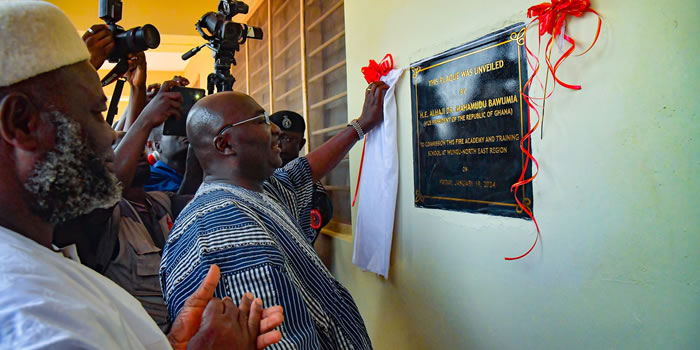

A previous socio-economic survey carried out in 1995 within some communities in the district has shown that 29.8% of the total populations have never had any kind of formal education.
Educational Facilities
The Directorate of Education in the West Mamprusi District has ten circuits viz; Walewale Central, Walewale East, Walewale West, Tinguri, Kpasenkpe East, Kpasenkpe West, Janga, Yagaba East, Yagaba West and Kparigu. The district has 32 pre-schools, 82 primary schools, 28 junior Secondary schools and 2 senior secondary schools. This is illustrated in Fig 8 below. Please refer to Annex 6 for details of educational facilities in the district.
Staffing Level
Of the 550 teachers in the district, 56 per cent are trained with the remaining 44.5 per cent untrained. (Table 11) Apart from the pre-schools, which have a higher percentage of untrained teachers (88 per cent) as against trained teachers (12 per cent), for primary and junior secondary schools, trained teachers form a higher percentage, 50.2 per cent and 81.7 percent respectively as against untrained teachers. This provides a good environment for quality education in the district. In the case of senior secondary, trained teachers account for 72 per cent of the 32 teachers.
STAFFING LEVEL | |||
INSTITUTION | TRAINED TEACHERS | UNTRAINED TEACHERS | TOTAL |
PRE-SCHOOL | 5 | 37 | 42 |
PRIMARY | 179 | 177 | 356 |
J.S.S | 98 | 22 | 120 |
S.S.S. | 23 | 9 | 32 |
| 305 | 245 | 550 |
It is imperative that the number of trained teachers must be increased in the district. The district shows the unacceptable situation of only 54% of trained teachers at the Senior Secondary School level.
Teacher/Pupil Ratio
The teacher-pupil ratios of nursery, primary, junior and senior secondary schools by circuit are shown in table 10 below. The district average teacher/pupil ratio is 1:38. A further breakdown shows that the S.S.S. and J.S.S. levels are well catered for. The primary school level (1:46) is just below the nationally accepted level of 1:40. The pre-school level however stands at 1:141, which is also
TEACHER-PUPIL RATIO | ||||
INSTITUTION | CIRCUIT | STAFFING | TOTAL ENROLEMENT | TEACHER/ PUPIL |
PRE-SCHOOL | Walewale | 33 | 1690 | 1:51 |
| Tinguri | 2 | 318 | 1:159 |
| Kpasenkpe | 4 | 687 | 1:172 |
| Janga | 3 | 248 | 1.83 |
| Yagaba | 0 | 0 | 0 |
AVERAGE |
|
|
| 1:141 |
PRIMARY | Walewale | 139 | 4227 | 1:30 |
| Tinguri | 25 | 1773 | 1:71 |
| Kpasenkpe | 25 | 2181 | 1:87 |
| Janga | 19 | 1901 | 1:100 |
| Yagaba | 9 | 1941 | 1:215 |
AVERAGE |
|
|
| 1:60 |
·
TEACHER-PUPIL RATIO | ||||
INSTITUTION | CIRCUIT | STAFFING | TOTAL ENROLEMENT | TEACHER/ PUPIL |
J.S.S | Walewale | 58 | 1426 | 1:25 |
| Tinguri | 11 | 233 | 1:21 |
| Kpasenkpe | 13 | 374 | 1:29 |
| Janga | 10 | 238 | 1.24 |
| Yagaba | 6 | 116 | 1:19 |
AVERAGE |
|
|
| 1:24 |
SSS | Walewale | 18 | 528 | 1:29 |
| Tinguri | 0 | 0 | 0 |
| Kpasenkpe | 14 | 296 | 1:21 |
| Janga | 0 | 0 | 0 |
| Yagaba | 0 | 0 | 0 |
AVERAGE |
|
|
| 1:28 |
Another look at the teacher – pupil ratio in the various circuits show a skew in the distribution of teachers in the district. At the primary school level, the Yagaba circuit had a ratio of 1:19 as compared to 1:30 in Walewale. At the pre-school level whereas Tinguri level showed 1:159, Walewale circuit .
School Enrolment
The current total enrolment of school children is 19,398 and made up of 10,797 males (representing 56%) and 8,601 females (representing 44%). This figure is 87% of the expected enrolment of 34,697.
Drop-Out Rate
Dropout from school is a common phenomenon in the District especially in the Yagaba Circuit (Overseas area) and particularly in P6 and P1. In the 1998/99 academic year, a total of 282 pupils in P1 dropped out of school, making a percentage of 8%. In P6, 63 dropped from school representing 5.9%. In JSS2, 51 pupils also dropped out from school.
In 1998, 1,548 pupils dropped out of school of an enrolment of 10,322. In 1999, this fell to 1,123 out of 11,229 pupils. The annual school drop out rate is estimated at 3.6%. In addition to the above, there is a high incidence of seasonal drop out. During the farming season, not less than 40% of the pupils in the district stop attending school. They help their parents on their farms.
The high drop-out rate of girls in school is the most significant phenomenon in the educational system in the district. Part of the problem can be attributed to the fact that as pupils grow up, they are needed in the house to take part in the tedious task of fetching potable water a task considered to be for females. The girls also tend to migrate to the south to work to get money to get married
Technical/ Vocational Education
There are no technical or vocational schools in the district and therefore no avenues for acquiring vocational skills. This does not auger well for development since this leaves most junior secondary school leavers without jobs. The District Assembly has however acquired land to put up a vocational school.
The district is vigorously pursuing non-formal education for the adult population. Currently there are 119 adult literacy classes with 2,756 learners. Out of the total number of learners, 1,668 are male whilst 1,008 are female. Through the efforts of the District Education and Administration offices, a vocational school was successfully opened in the 2002/2003 academic year. The school has an enrolment of sixty students made up of females
PROBLEMS
Poor Infrastructure Facilities
One factor that has hindered the development of education in the district is poor infrastructural facilities viz; lack of classrooms and existence of weak school buildings. Out of the 110 basic schools, only 33 are habitable and good enough to be used for effective teaching and learning. The remaining 77 schools have various problems ranging from lack of doors and windows to incremented floors More that 8,500 children in the district lie on their bellies to write during classes, while others sit on stones and planks of wood to write.
Tables and chairs for teachers are inadequate. Classroom cupboards needed to store schoolbooks are inadequate. In addition, most schools do not have Head teachers’ Offices and storerooms. This has put educational materials in the schools at risk. Residential facilities for teachers in the district are a problem and this does not attract teachers to the district.
Teaching and Learning Materials
Another problem affecting education in the district is the short supply of textbooks in various basic schools. In other cases, there are no syllabus books and teachers handbooks are inadequate to match the textbooks.
Inaccessibility to Certain Communities
About 30 of the schools in the district are inaccessible out of which 23 are in the “Overseas” area of the Yagaba Circuit. Such areas are liable to floods and during the rainy season, schooling is suspended as school buildings are washed down.
Inadequate Staffing
One problem hindering the growth of education in the district is inadequate staffing. A total of 600 teachers are expected to man the 99 basic schools in the district. The existing staff strength is 550 out of which 245 are untrained. Inadequate staffing has driven some pupils out of school. In the “Overseas” area, some 9 schools have been closed down due to lack of teachers.
Inadequate Facilities at the Education Directorate
The four-room office accommodation of the District is very inadequate. With an establishment of sixty-one, the rooms are over congested and productive work is always a drawback. The District Office also lacks equipment like photocopying machines, good typewriters, and cabinets for storing information. Office furniture are also inadequate.
Measures to Address Situation
In order to attract and retain the required quota of teachers in the district, teachers should be given improved accommodation and teaching conditions. In addition, financial incentives may be given to those in the deprived areas especially “Overseas”.
To solve the staffing problems in the district, efforts should be made to sponsor students to go through teacher training college. These students should be bonded as part of the sponsorship terms and conditions.
It is urgent that the District Assembly rehabilitates and improves educational facilities in the District. Where these facilities are not available, efforts should be made to construct them. This will increase any activities towards enrolment drive.
Educational facilities should be maintained periodically. This would reduce structures being in states of disrepair. Schools should be provided with teaching and learning aids to ensure effective teaching.
The establishment of a vocational institute in the district to provide employable skills to the huge army of unemployed youth is very critical. The District Assembly should make the necessary efforts to provide a more spacious accommodation for the District Directorate of Education.
Date Created : 11/27/2017 3:47:19 AM











 facebook
facebook
 twitter
twitter
 Youtube
Youtube
 +233 593 831 280
+233 593 831 280 0800 430 430
0800 430 430 GPS: GE-231-4383
GPS: GE-231-4383 info@ghanadistricts.com
info@ghanadistricts.com Box GP1044, Accra, Ghana
Box GP1044, Accra, Ghana